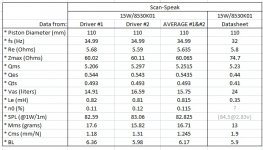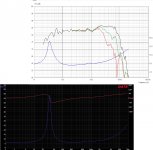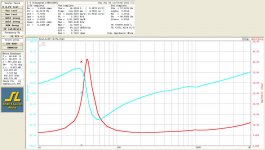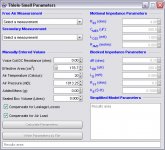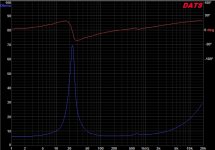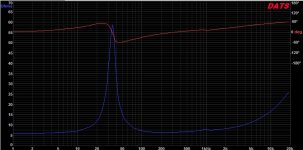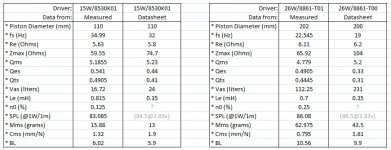I've been using the Dayton Audio Test System to test my scan-speak mids, the 15w8530K01. I've attached my results for the two drivers, also an average of the two and then what the data-sheet suggested. In general things aren't perhaps a million miles away from the data sheet, but I see that Le and Vas in particular are quite different.
I did run the drivers in, for about a week on a 10Hz sine wave with healthy excursion, and have followed the DATs instructions on letting it settle, then setting the USB port and system volume correctly, and have run both the lead impedance and reference resistor calibrations... so there doesn't 'seem' much else to go wrong. The measurements were made with the driver hanging almost vertically in free air (on a bungee), and Vas was achieved by the added mass method via a small magnet and some steel either side of the cone, totalling 65g.
Obviously, I expect 'some' deviation from the nominal spec but I lack the experience to know how much is normal. Can anyone say if this amount of disagreement is reasonable, or should I be looking for some error in my measurements?
Many Thanks
Kev
I did run the drivers in, for about a week on a 10Hz sine wave with healthy excursion, and have followed the DATs instructions on letting it settle, then setting the USB port and system volume correctly, and have run both the lead impedance and reference resistor calibrations... so there doesn't 'seem' much else to go wrong. The measurements were made with the driver hanging almost vertically in free air (on a bungee), and Vas was achieved by the added mass method via a small magnet and some steel either side of the cone, totalling 65g.
Obviously, I expect 'some' deviation from the nominal spec but I lack the experience to know how much is normal. Can anyone say if this amount of disagreement is reasonable, or should I be looking for some error in my measurements?
Many Thanks
Kev
Attachments
Hmm, having spent the evening testing the drivers, I just closed down the DATs software to find a windows box behind it saying I need to restart for the settings to take effect. I assume this is related to setting up the USB port, so I may have wasted the evening's testing. <sigh>
EDIT: well I've repeated the tests and Vas has improved a tad but Le is still almost identical to the earlier values, i.e. more than double what the spec sheet suggests..
Cheers
Kev
EDIT: well I've repeated the tests and Vas has improved a tad but Le is still almost identical to the earlier values, i.e. more than double what the spec sheet suggests..
Cheers
Kev
Last edited:
I could scream all day about pop unders! errr don't ya just hate that?!
Reboot that puppy and lets see the next round of tests. The numbers don't look that far off
Be careful driving a speaker that low. It's actual power spec at those frequencies is much lower. Re check Re with a meter after either setting it's zero reference or subtracting the lead resistance from the measurement.
I have read about everyones opinion on how to properly break in a driver and the extreme breakin strategy that Mark at Mark Audio seems to be the most restrictive time intensive regime there is. Not that I disagree with Mark merits on most fronts. Me I'll impedance sweep it and run a test signal that is a bit lower than Fs and slowly increase power til I'm about to where Xlin would be. How long depends on the drivers Qms, higher, longer and lower, shorter. Last breakin took two hours free space. Fs dropped 2 Hz. Out of a dozen all are within ½Hz of each other and 4 have well over a hundred hours on them.
Reboot that puppy and lets see the next round of tests. The numbers don't look that far off
Be careful driving a speaker that low. It's actual power spec at those frequencies is much lower. Re check Re with a meter after either setting it's zero reference or subtracting the lead resistance from the measurement.
I have read about everyones opinion on how to properly break in a driver and the extreme breakin strategy that Mark at Mark Audio seems to be the most restrictive time intensive regime there is. Not that I disagree with Mark merits on most fronts. Me I'll impedance sweep it and run a test signal that is a bit lower than Fs and slowly increase power til I'm about to where Xlin would be. How long depends on the drivers Qms, higher, longer and lower, shorter. Last breakin took two hours free space. Fs dropped 2 Hz. Out of a dozen all are within ½Hz of each other and 4 have well over a hundred hours on them.
Yeah, most annoying. I don't have time tonight to repeat the tests, but I'll definitely have another go tomorrow night or at the weekend and update my figures. One other thing I noticed is that if I take a few readings the first tends to differ a bit from subsequent ones, almost as if something warms up or settles during the first test.
The breaking-in thing is interesting; I guess mine will be well done, then! I was quite careful not to let their excursion reach any physical limits though, and they didn't get noticeably warm either, so hopefully I won't have actually overdone anything.
Cheers
Kev
The breaking-in thing is interesting; I guess mine will be well done, then! I was quite careful not to let their excursion reach any physical limits though, and they didn't get noticeably warm either, so hopefully I won't have actually overdone anything.
Cheers
Kev
That sounds encouraging. So I seem to be getting generally sensible results, which is why I'm a little surprised Le is so different to the generic/nominal spec. I do want to repeat the measurements more carefully, but Le does seem to be quite consistently 0.81mH vs the suggested 0.35mH, which seems quite a large percentage difference.
The Vas I got after rebooting windows was around 18.5, which is a step closer to the 24 specified than my original readings; maybe I should try it via the box method to see how it compares, though I'd have to make one first.
Cheers
Kev
The Vas I got after rebooting windows was around 18.5, which is a step closer to the 24 specified than my original readings; maybe I should try it via the box method to see how it compares, though I'd have to make one first.
Cheers
Kev
.....but I see that Le and Vas in particular are quite different.
WRT Le, I calc ~ 0.9038 mH/1 kHz off the published impedance plot Vs ~0.8769 mH for your averaged specs, so either the impedance plot is wrong or the published spec is a typo and since your plot is near enough the same at 1 kHz, I'm going with the typo.
FWIW, I calc n0 = 0.172%, SPL = 84.38 Hz/W/m with the published specs.
GM
Thats reassuring, especially on Le, so thanks chaps.
I'll try repeating the measurements more carefully tonight and see if the VAS gets any closer. One other thing I noticed last night is that the amount of added mass used seems to give slightly different results; the DATS software tells me if its insufficient, but maybe over and above that theres also an optimum amount that it doesn't indicate; I'll have to read up on it.
Cheers
kev
I'll try repeating the measurements more carefully tonight and see if the VAS gets any closer. One other thing I noticed last night is that the amount of added mass used seems to give slightly different results; the DATS software tells me if its insufficient, but maybe over and above that theres also an optimum amount that it doesn't indicate; I'll have to read up on it.
Cheers
kev
Last edited:
This is my WT2 test on the same driver, but NOT broken in. Although the results don't match well with SS's specs, I used them in a 15L vented box and WOW! amazing bass from such a small driver. What's also amazing about the bass/mid is its ability to go so low and still produce great midrange - at least in my Intimates (http://www.diyaudio.com/forums/multi-way/226976-two-way-crossover-no-capacitors.html post #7) speakers.
This driver easily gets down to 40 hz in a 15L vented cabinet or, about 60 hz sealed. You made a good investment in a great driver.
The Vas test is perhaps the most difficult to do as far as matching anyone else's results. Not worth obsessing over unless drivers testing is your thing to do.
This driver easily gets down to 40 hz in a 15L vented cabinet or, about 60 hz sealed. You made a good investment in a great driver.
The Vas test is perhaps the most difficult to do as far as matching anyone else's results. Not worth obsessing over unless drivers testing is your thing to do.
Attachments
Last edited:
Excellent, many thanks for that! It looks much closer to my results than the spec sheet's, which is reassuring. As these are my first steps in driver testing I lack the experience to put the results in perspective, but it does appear that I'm probably not too far off the mark.
I was lucky enough to get these drivers as new-old stock but they were still quite expensive by my standards, so your experiences with them sound extremely positive. I won't begrudge the cost at all if they perform well; I'll probably be using them for years if not decades
Cheers
kev
I was lucky enough to get these drivers as new-old stock but they were still quite expensive by my standards, so your experiences with them sound extremely positive. I won't begrudge the cost at all if they perform well; I'll probably be using them for years if not decades
Cheers
kev
Excellent, many thanks for that! It looks much closer to my results than the spec sheet's, which is reassuring. As these are my first steps in driver testing I lack the experience to put the results in perspective, but it does appear that I'm probably not too far off the mark.
I was lucky enough to get these drivers as new-old stock but they were still quite expensive by my standards, so your experiences with them sound extremely positive. I won't begrudge the cost at all if they perform well; I'll probably be using them for years if not decades
Cheers
kev
I strongly suggest you review my Intimates design and consider building a pair. I don't know what, if any, tweeters you have, but the ones I used are vital to the success of the design.
As you wrote: I"ll probably be using them for years, if not decades.....
Temperature
I had a quick look at the DATS software and couldn't find any room temperature setting in the screenshots .
From my experience with REW measuring my drivers T/S parameters and living in Australia I have seen big differences in the measured parameters if the room temperature is just a few degrees of the settings in REW .
Is the DATS box temperature compensated ? Maybe you can do some tests with a driver in different room temperatures ?
I always cool my room to 20 C and measure ASAP .
Cheers ,
Rens
I had a quick look at the DATS software and couldn't find any room temperature setting in the screenshots .
From my experience with REW measuring my drivers T/S parameters and living in Australia I have seen big differences in the measured parameters if the room temperature is just a few degrees of the settings in REW .
Is the DATS box temperature compensated ? Maybe you can do some tests with a driver in different room temperatures ?
I always cool my room to 20 C and measure ASAP .
Cheers ,
Rens
Attachments
Thanks, i'll definately look that thread over - they certainly look the business. I'm actually using these as mids in 3-ways initially, but i'm sure there will be useful pointers to be learnt from your design even if I'm not copying it directly. I like what you say about their low frequency performance too, as I particularly wanted the flexibility to experiment with the crossover point; one future project i'd like to try would be using them in a 2-way+stereo sub setup. My tweeters are the ScanSpeak Discovery D2608/913000 (replacements for the Peerless HDS 810921) in a couple of Pellegrene Acoustics #6531516 waveguides - all new ground for me!I strongly suggest you review my Intimates design and consider building a pair. I don't know what, if any, tweeters you have, but the ones I used are vital to the success of the design.
cheers
kev
Ah,yes - I must admit that I hadn't considered temperature, and it is quite cold here at the mo. The DATS itself can be calibrated at whatever temperature its currently at, but I've not seen anything about driver temperature. I'll have a look through the software and see if theres anything mentioned; if not guess I should try to test at some sort of average for my room. In fact thinking about it the quick start instructions I've been using are pretty minimal, theres probably some greater detail on these things given somewhere.I had a quick look at the DATS software and couldn't find any room temperature setting in the screenshots .
From my experience with REW measuring my drivers T/S parameters and living in Australia I have seen big differences in the measured parameters if the room temperature is just a few degrees of the settings in REW .
Is the DATS box temperature compensated ? Maybe you can do some tests with a driver in different room temperatures ?
I always cool my room to 20 C and measure ASAP .
Cheers ,
Rens
Thanks for the idea!
Cheers
kev
Right, I re-measured the drivers, acclimatised to room temperature and with no windows pop-unders. It hasn't changed greatly - attached are the traces and the numbers.
Allowing for individual driver variations, the 15w TS parameters should be comparable with the datasheet column - although Le and Vas aren't especially, which is still a bit of a puzzle.
However, the 26w is an OEM variant and the only datasheet I have is for its nearest/mainstream brother - so the columns for the 26w drivers are not necessarily expected to agree, I was just interested to see how the OEM one compared.
Cheers
Kev
Allowing for individual driver variations, the 15w TS parameters should be comparable with the datasheet column - although Le and Vas aren't especially, which is still a bit of a puzzle.
However, the 26w is an OEM variant and the only datasheet I have is for its nearest/mainstream brother - so the columns for the 26w drivers are not necessarily expected to agree, I was just interested to see how the OEM one compared.
Cheers
Kev
Attachments
- Status
- This old topic is closed. If you want to reopen this topic, contact a moderator using the "Report Post" button.
- Home
- Loudspeakers
- Multi-Way
- DATS measurement of 15w8530K01, odd?
